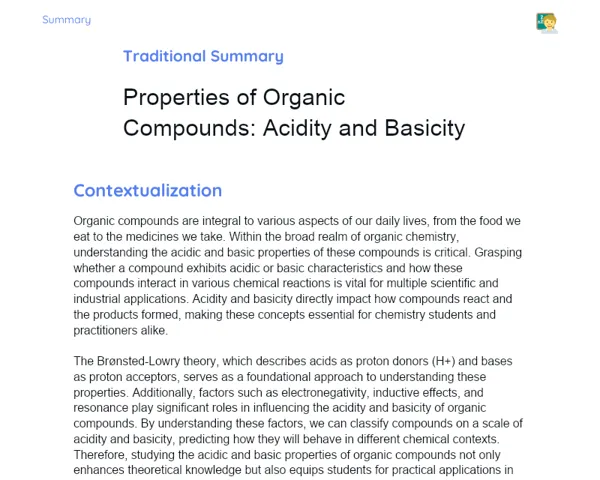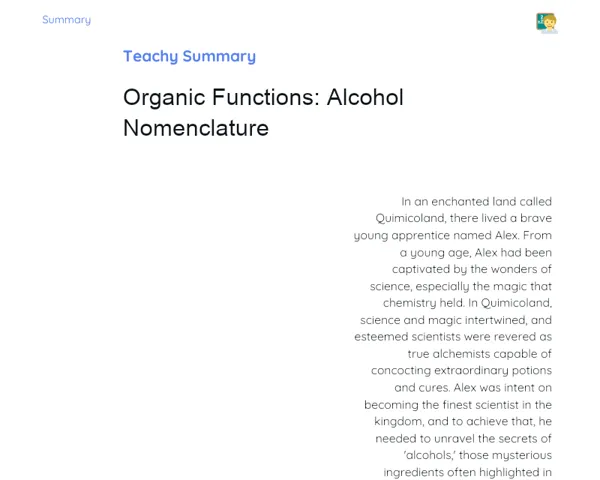Objectives
1. 🎯 Identify and distinguish nitro compounds from other types of organic compounds, grasping their unique chemical structure.
2. 🎯 Master IUPAC nomenclature for nitro compounds, applying the prefix 'nitro' and other naming criteria accurately and confidently.
Contextualization
Nitro compounds are not just a fascinating aspect of organic chemistry; they play a crucial role in various industries, from explosives to pharmaceuticals. Take trinitrotoluene, or TNT, for example—it's well-known for its explosive properties. But did you know that nitro compounds are also essential in creating certain dyes and medications? This lesson will enhance your theoretical knowledge while also shedding light on the practical significance of these compounds in both industrial and everyday contexts. Ready to dive into the explosive world of nitro compounds? 💥
Important Topics
Nitro Group (-NO2)
The nitro group is one of the most fascinating functional groups in organic chemistry, made up of a nitrogen atom bonded to two oxygen atoms, usually depicted as -NO2. This group typically attaches to a carbon backbone, significantly changing the chemical properties of the original compound. Its presence is a key indicator in chemical reactions, particularly in the production of explosives and pharmaceuticals.
-
Reactivity: Nitro compounds are highly reactive, making them invaluable in the explosives industry due to their capacity to release large amounts of energy rapidly.
-
Polarity: The nitro group enhances the polarity of the compound, impacting its solubility and reactivity, which are vital traits in drug development.
-
Synthesis: Incorporating the nitro group into organic molecules is a crucial step in chemical synthesis, especially in dye and polymer production.
IUPAC Nomenclature for Nitro Compounds
IUPAC nomenclature is a globally recognized system that guarantees every new organic compound has a unique and unambiguous name. In the case of nitro compounds, the nitro group is treated as a substituent, using the prefix 'nitro'. The rest of the name is constructed from the main carbon chain, accompanied by a numeric locator indicating the nitro group's position in that chain.
-
Standardization: IUPAC nomenclature allows scientists worldwide to communicate clearly about specific compounds, minimizing misunderstandings.
-
Location: It’s vital to accurately identify where the nitro group is placed in the carbon chain, as this can drastically influence the compound's properties.
-
Multiple Compounds: In molecules housing more than one nitro group, each must be indicated by a fitting numeric prefix to clarify its location.
Practical Applications of Nitro Compounds
Beyond their fundamental role in producing explosives, nitro compounds are crucial in various other industries. They are employed in the manufacture of pharmaceuticals, where their characteristics assist in devising more effective medicines, and play a role in the dye industry, enhancing the quality and stability of pigments used in clothing and paints.
-
Medicines: Numerous pharmaceuticals contain nitro compounds within their structures, harnessing their reactivity to treat illnesses.
-
Dyes: Nitro compounds are integral components in dye synthesis, particularly for those used in robust paints and fabrics.
-
Food Industry: On a smaller scale, certain nitro compounds are utilized to enhance flavors and preserve foods, showcasing their versatility.
Key Terms
-
Nitro Group (-NO2): A functional group in organic chemistry consisting of a nitrogen atom bonded to two oxygen atoms and linked to a carbon chain.
-
IUPAC Nomenclature: An international chemical naming system that provides a standardized method for naming chemical compounds.
-
Reactivity: Refers to the tendency of a chemical substance to undergo a chemical reaction.
-
Polarity: A measure of how electric charges are distributed in a molecule.
For Reflection
-
How can the presence of a nitro group change the physical and chemical properties of an organic compound?
-
Why is it crucial to use IUPAC nomenclature accurately when discussing chemical compounds, especially in scientific research?
-
What could be the consequences of incorrectly applying IUPAC nomenclature in industrial settings, like medicine or explosives manufacturing?
Important Conclusions
-
We revisited the fascinating chemistry of nitro compounds, spotlighting their unique structure and the importance of correct IUPAC nomenclature for effective scientific communication.
-
We explored the practical applications of nitro compounds in industries like pharmaceuticals, food, and explosives, demonstrating how this knowledge is relevant to our daily lives.
-
We acknowledged the importance of precision in naming and locating nitro groups within organic compounds, underlining how even minor changes can greatly impact a substance's properties.
To Exercise Knowledge
💥 Home Laboratory: Crafting Molecular Models - Use simple materials like modelling clay or coloured paper to create models of nitro compounds. Name each one according to IUPAC nomenclature and explain their potential practical applications in a creative presentation for your family or friends.
Challenge
🔎 Chemical Detective Challenge - Locate a product at home that possibly contains nitro compounds (like medicines or food dyes) and examine its label and composition. Present your discoveries in a creative report, discussing how nitro compounds are utilized and their significance.
Study Tips
-
📚 Create colourful summaries of the lesson’s key points, using markers to highlight IUPAC nomenclature rules.
-
👀 Watch online videos explaining the synthesis and reactions related to nitro compounds to better visualise the concepts discussed.
-
🔗 Collaborate with your peers to discuss and work on practical exercises about nomenclature together, reinforcing mutual learning.


